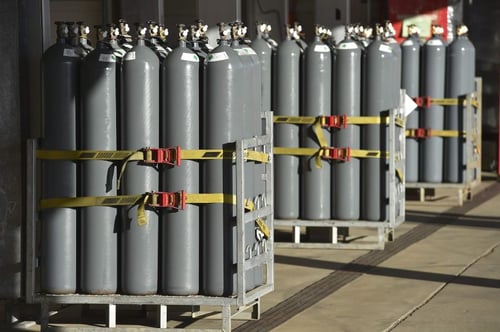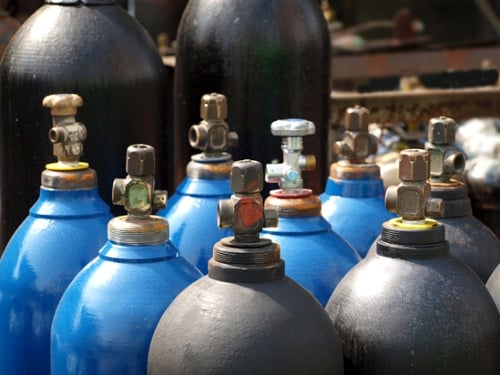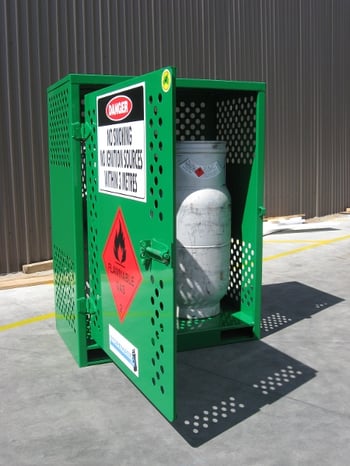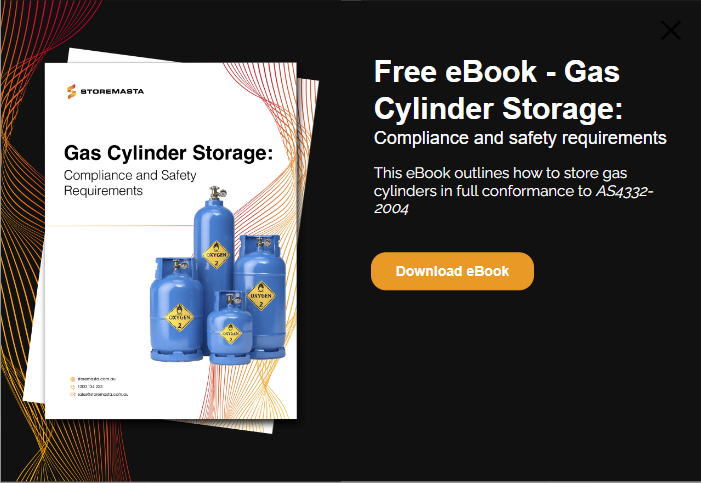While compressed gases are used in workplaces everywhere, it’s important to remember that they’re classified as dangerous goods in Australia. To provide the proper storage and handling procedures for gas cylinders, you must first be aware of the different types of gas bottles – as well as the risks that they present. In this post, we’ll highlight the different types of gas cylinders found in the workplace, as well as offer tips for their safe storage and handling.
What are the Different Types of Gas Cylinders?
We’ll kick off this post by introducing you to three types of cylinders that are common in workplaces across Australia. You’re probably already working with at least one of these types of gas bottles in your daily operations.
High Pressure Industrial Gas Cylinders
These cylinders are used across industrial applications and can store a range of gases including carbon dioxide and hydrogen.
Acetylene Cylinders
This type of gas cylinder stores acetylene gas dissolved in a solvent, such as acetone. This dissolved gas is widely used for welding and cutting operations.
LPG Cylinders
One of the most widely used cylinder types, LPG bottles are cylinders which store Liquified Petroleum Gas. This gas has an array of applications from fuel to cooking.
TIP: if you need to know how to manage the risks relating to storing the different types of gas cylinders at your workplace, download our free eBook Gas Cylinder Storage: Compliance and Safety Requirements today.
What are Gas Bottles Made of?
To contain dangerous goods such as LPG, acetylene and industrial gases, gas bottles must be strong, durable and chemically compatible with the gas that they’re storing. We’ll detail what each of the gas cylinder types is made from below:
What are High Pressure Industrial Gas Bottles Made of?
High pressure industrial gas cylinders are made from aluminium or steel. This heavy-duty construction allows compressed gases to be safely used and transported.
What are Acetylene Gas Bottles Made of?
As acetylene cylinders store acetylene gas dissolved in acetone, they are constructed differently to other gas bottles. These cylinders are constructed with steel and feature a porous mass within the bottle.
We’ll explain why the cylinders need this porous mass a little later in the blog.
What are LPG Gas Bottles Made of?
Liquified petroleum gas cylinders are usually constructed from steel, but they can also be made with aluminium.
Understanding High Pressure Industrial Gas Cylinders
High pressure industrial gas cylinders are designed to store industrial gases such as nitrogen, helium, hydrogen, oxygen and carbon dioxide. However, gases under high pressure can present serious health and safety hazards if they’re not stored and handled correctly.
For the health and safety of your team, it’s essential that you fully understand both the health hazards (toxic gases, corrosive gases, asphyxiants) of the gases you use, as well as the physiochemical hazards of the cylinders themselves.
While many compressed gases have flammable, corrosive and self-reactive properties, even non-flammable and non-toxic gases can become dangerous.
Cylinders may become loose, heated or start to disperse gas in an uncontrolled manner. This can cause workplace accidents and fatalities due to the unsecured cylinders releasing gas in an uncontrolled manner. Gas cylinders can turn into a torpedo-like projectile, which can produce serious incidents of harm for both people and property.

If left unsecured, high pressure gas cylinders can become projectiles and cause devestation to staff and property.
Risks Associated with High Pressure Industrial Gas Cylinders
The specific risks associated with high pressure industrial gas cylinders will be determined by the tap of gas that the cylinder is storing. Other risks will be due to the way the cylinder is used, maintained or stored.
Risks associated with high pressure gas cylinders include:
- Oxidizing gases can cause combustible substances to spontaneously ignite, they need to be separated from flammables, heat and ignition sources.
- Flammable gases pose the risk of fire or explosion, and must be stored correctly away from heat, oxidisers and ignition sources.
- Gas leaks from damaged or faulty cylinders, valves and connections can create unsafe exposure levels to toxic, corrosive and flammable gases. To prevent these health hazards, cylinders and manifolds should be inspected, maintained and serviced regularly by qualified technicians.
- High pressure industrial gas cylinders are heavy and very awkward to manoeuvre. Apart from manual handling injuries, dropping or causing cylinders to strike each other can damage valves and cause gases to rapidly disperse. Staff need to be well trained in manual handling techniques and, in many instances, you’ll need to purchase industrial lifting and carrying devices.
- Gas cylinders can easily fall or be knocked over causing air contamination and dangerous free flow. Cylinders should be secured on trolleys or stored in gas bottle cages.
What are Acetylene Cylinders?
Acetylene is an excellent fuel for heating as the gas burns hot and is regarded as an efficient fuel source. Used for industrial welding and cutting, acetylene mixed with oxygen is the only flammable gas capable of welding steel.
However, acetylene is a very unstable gas that’s capable of undergoing a dangerous chemical reaction known as decomposition. Decomposition generates a lot of heat, which can cause acetylene to ignite spontaneously. If pure acetylene is dispensed into the atmosphere at a pressure greater than15psi, it can violently decompose and explode by itself without a spark or flame.

These cylinders are constructed to inhibit the decomposition reaction of the acetylene mixture.
Because of the high risk of decomposition, acetylene cannot be stored in the same way as other gases. Instead, this gas must be dissolved in a solvent (usually acetone) and supplied in special cylinders containing a porous filler material called a monolithic porous mass. The porous mass within the cylinder inhibits the decomposition, thereby allowing an amount of time for emergency responses to be actioned in the event of an accident.
Risks Associated with Acetylene Cylinders
As you might expect, acetylene cylinders require additional precautions and care due to their ability to decompose and explode. Decomposition can be triggered by a flashback from welding and cutting equipment. Employees should be properly trained in safe welding and cutting techniques.
Acetylene can also decompose when exposed to intense heat, cylinders should be stored in a fireproof area away from heat sources.
To prevent the acetone and acetylene from separating, acetylene cylinders must be stored in an upright position — at all times.
It’s also important to note that acetylene reacts explosively with pure copper, brass, silver and mercury, so alloy valves and reticulation systems must only contain small percentages of these metals.
Employees must use extreme care when handling these cylinders, as rough handling or heating due to shock may result in a delayed explosion. Make sure they are not dropped or even allowed to strike one another.
Valves must be opened slowly to prevent rapid dispensing of the gas. If acetylene flows too quickly, it can create static electricity sparks or solvent loss. Either event will result in decomposition and an explosion.
Liquified Petroleum Gas (LPG) Cylinders
LPG is used in many workplaces for cooking, heating, cutting and fuelling vehicles, such as forklifts. But LPG is a highly flammable gas — and an asphyxiant — so extreme care must be taken when handling and storing LPG cylinders.
Because LPG is so common around both the home and workplace, we sometimes don’t give this type of dangerous good the respect it deserves. However, even the LPG cylinders that you use at BBQs or camping have the ability to cause harm if they’re not handled and stored in the right way.
As LPG is highly flammable and an asphyxiant, compliant storage with adequate ventilation is essential.
Risks Associated with LPG Cylinders
In addition to the risks associated with high pressure industrial gases, LPG also has the following risks and hazards:
- LPG is extremely flammable, which means that cylinders can explode if they’re subjected to a workplace fire. Make sure you use and store LPG cylinders away from heat, oxidisers and ignition sources. LPG can ignite from burning cigarettes, open flames, spark producing switches/tools, heaters, naked lights, pilot lights, mobile phones etc, even the remote control from your car’s central locking system.
- As this gas is denser than air, it will collect in low lying areas, such as pits and basements. This presents an asphyxiation, fire or explosion hazard. Keep cylinders, valves and regulators well maintained and regularly serviced to avoid leaks. Turn off valves when the cylinder is not being used and make sure that fittings like welding torches are removed when the cylinder is not being used or in storage.
- As LPG is an asphyxiant, it must only be used in well ventilated areas. Don’t use or store the gas in confined spaces, closed rooms or areas that are not ventilated.
Taking the Next Step in Gas Bottle Safety
Thanks for reading our blog on the different types of gas cylinders commonly found in Australian workplaces. If you’d like to take the next step in gas bottle safety, we strongly encourage you to keep reading through our full blog series (see below). This will help you gain a greater understanding of your legal obligations without having to interpret long, detailed legislation or complex Australian Standards.
If you'd like to learn more about managing the risks associated with storing gas cylinders, you can also download our free eBook. Gas Cylinder Storage: Compliance and Safety Requirements will guide you through all the must-know requirements, so you can create a safer and more compliant workplace.
Like what you’re reading? Explore our full gas bottle blog series:
Gas Bottle Storage Requirements
LPG Gas Bottle Storage Regulations
What are Class 2.1 Flammable Gases?
A Guide to Flashback Arrestor Inspection and Testing
Joining the team as a Dangerous Goods Storage Consultant, Melissa Hampton became Storemasta's Marketing Manager in late 2021. With extensive knowledge and experience in chemical compliance, Melissa is responsible for leading the Marketing team and helping shape their marketing strategy. In her spare time, you can find Melissa hiking, swimming and enjoying the great outdoors in beautiful north-west Tasmania.

